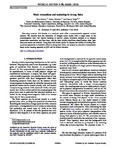Mode truncations and scattering in strong fields
| dc.contributor.author | Heinzl, Thomas | |
| dc.contributor.author | Ilderton, A | |
| dc.contributor.author | Seipt, D | |
| dc.date.accessioned | 2018-09-10T06:22:45Z | |
| dc.date.available | 2018-09-10T06:22:45Z | |
| dc.date.issued | 2018-07-03 | |
| dc.identifier.issn | 2470-0010 | |
| dc.identifier.issn | 2470-0029 | |
| dc.identifier.other | 016002 | |
| dc.identifier.uri | http://hdl.handle.net/10026.1/12252 | |
| dc.description | 18 pages, 1 pdf figure. Version 2: abbreviated presentation, results unchanged. Matches version to appear in Phys.Rev.D | |
| dc.description.abstract |
Truncating quantum field theories to a dominant mode offers a nonperturbative approach to their solution. We consider here the interaction of charged scalar matter with a single mode of the electromagnetic field. The implied breaking of explicit Lorentz invariance prompts us to compare instant-form quantization and front form, with the latter yielding significant simplifications when light-front zero modes are included. Using these field theory results we reassess the validity of existing first-quantized approaches to depletion effects in strong laser fields, and propose an alternative interpretation based on the dressing approach to QED and its infrared structure. | |
| dc.format.extent | 016002- | |
| dc.language | en | |
| dc.language.iso | en | |
| dc.publisher | American Physical Society (APS) | |
| dc.subject | hep-th | |
| dc.subject | hep-th | |
| dc.subject | hep-ph | |
| dc.title | Mode truncations and scattering in strong fields | |
| dc.type | journal-article | |
| dc.type | Journal Article | |
| plymouth.author-url | https://www.webofscience.com/api/gateway?GWVersion=2&SrcApp=PARTNER_APP&SrcAuth=LinksAMR&KeyUT=WOS:000437112700006&DestLinkType=FullRecord&DestApp=ALL_WOS&UsrCustomerID=11bb513d99f797142bcfeffcc58ea008 | |
| plymouth.issue | 1 | |
| plymouth.volume | 98 | |
| plymouth.publisher-url | http://dx.doi.org/10.1103/PhysRevD.98.016002 | |
| plymouth.publication-status | Published online | |
| plymouth.journal | Physical Review D | |
| dc.identifier.doi | 10.1103/physrevd.98.016002 | |
| plymouth.organisational-group | /Plymouth | |
| plymouth.organisational-group | /Plymouth/Faculty of Science and Engineering | |
| plymouth.organisational-group | /Plymouth/Faculty of Science and Engineering/School of Engineering, Computing and Mathematics | |
| plymouth.organisational-group | /Plymouth/REF 2021 Researchers by UoA | |
| plymouth.organisational-group | /Plymouth/REF 2021 Researchers by UoA/EXTENDED UoA 10 - Mathematical Sciences | |
| plymouth.organisational-group | /Plymouth/REF 2021 Researchers by UoA/UoA10 Mathematical Sciences | |
| plymouth.organisational-group | /Plymouth/Users by role | |
| plymouth.organisational-group | /Plymouth/Users by role/Academics | |
| dc.identifier.eissn | 2470-0029 | |
| dc.rights.embargoperiod | Not known | |
| rioxxterms.versionofrecord | 10.1103/physrevd.98.016002 | |
| rioxxterms.licenseref.uri | http://www.rioxx.net/licenses/all-rights-reserved | |
| rioxxterms.type | Journal Article/Review |


